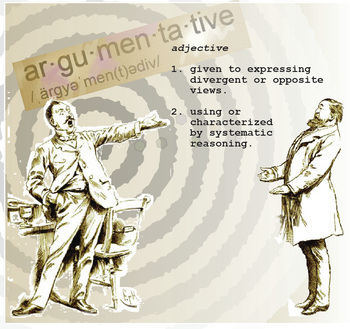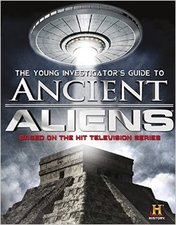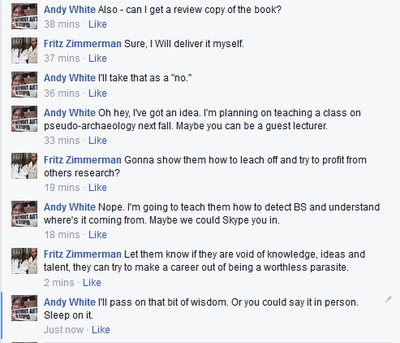|
The second student project video from this year's Forbidden Archaeology class is now posted on YouTube. In this video, three students discuss some of the evidence that's bandied about for the extra-terrestrial origin of the Anunnaki. They've already gotten their first thumbs down. Enjoy! Tomorrow I'll be posting one on the Nephilim, but I won't write a blog post about it. Check my YouTube channel tomorrow morning if you're interested. [Update: here it is.]
 I'm about to get on airplane for some holiday travel. I'm hoping to spend much of the coming week not doing much work, but I've been working hard over the last few weeks to finish a "beta" (i.e., mostly complete) version of The Argumentative Archaeologist website. It's done! Go have a look! Please spread the word. I don't have time to write much about it now, so I'm just going to paste in the content from the About page: The Argumentative Archaeologist is a website that organizes and compiles links to fact-based information and analysis related to fantastic claims about the human past. While not all "fringe" (i.e., non-mainstream) claims have been shown to be untrue, many have (some of them over, and over, and over again . . .). The goal of this site is to provide road maps to information that will help you both identify what's BS and understand the history and context of some of the many claims about the past that can be shown to be false. They can't all be true, right?. Who Are the Intended Audiences? This site was conceived and designed with three main audiences in mind:
How Do You Choose the Content? The content in this site was not chosen to give "equal time" to skeptical and "fringe" voices. As mentioned above, the "fringe" side of the equation has developed a powerful set of tools to communicate its various messages: it does not require any assistance. This site is intended to serve as a counterpoint to "fringe" claims, providing links to critical analyses of components of those claims, links to critical reviews of "fringe" media, and a structure that lets the user explore and understand how various components of "fringe" claims are inter-connected. During the initial construction of this site (October-November 2015), I mined the blogs of several of the major skeptical online voices of which I am aware: Jason Colavito, ArchyFantasies, Bad Archaeology, Glen Kuban, Skeptoid, Le Site d'Irna, Michael Heiser, Ancient Aliens Debunked, Hot Cup of Joe, and my own website (Andy White Anthropology). This site does not link to all posts on those websites, of course, but it links to many that are related to the topics of interest here. My plan is to monitor those sites and add links to new posts (and new topics) as they become available. I would love to hear about articles, posts, and other skeptical sites of which I am unaware (please use the Suggestion Box). Why Do You Present the Content the Way You Do? The work of critically evaluating "fringe" claims about the human past is being done by very few individuals. I hope that this site brings attention (and web traffic) to their efforts. My guess is that most of us who take the time to investigate and write something about the nonsense that's being sold as knowledge aren't making any money by doing so (in stark contrast to the "fringe" side, which has a large commercial component). Credit should go where credit is due: write an email and thank your favorite skeptic for his or her hard work. I have used block quotes to introduce many of the topics, artifacts, and sites for which I have created entries. Many of those quotes are from Wikipedia. I chose to do this not because it is the best source of information, but because it probably reflects a reasonable consensus view. And it's designed to be "open." I've attributed the textual quotes that I use, and I've attributed the sources of images that I use by linking to my sources. I have added internal links (i.e., links pointing to other pages within this website) and indicated those changes with the designation [links added]. I do not believe that I am violating any copyrights or other prohibitions by presenting the material the way I do. If you disagree, please let me know via email ([email protected]). What Do I Do Now? Begin your search for information by Topic, by Person, by Geographical Area, by Title of a book, film, or television program, by Meme or Image, or Alphabetically. Please use the Suggestion Box to offer topics or links to information, and please sign the Guestbook. Enjoy!  This is just a very quick post to point you in the direction of a blog post today by Jason Colavito, writing about a new Ancient Aliens "guide" for kids 8-12 years of age, endorsed by the History Channel. The description of the book is as follows: "Spanning history, from the earliest of human civilizations to the modern period, this book exposes evidence of the presence of extraterrestrials in some of our most triumphant and devastating moments." You've got to be kidding me. Let me look into my crystal ball and predict that this will someday qualify as a significant datapoint in the narrative arc of our dumbification as a nation. I've got an idea. A common refrain among those claiming to be interested in discovering the "forbidden truths" about our prehistory is that mainstream archaeologists and academics are actively involved in a conspiracy to suppress information, hide evidence, censor ideas, and generally keep the world from knowing what really happened in the past. The charge that mainstream archaeologists are hiding evidence to protect the status quo is not just incidental to theorists on the fringe: it is a central plank used over and over again to explain the absence of positive evidence for their claims. The absence of positive material evidence for a claim, in fact, is sometimes used to support the contention that a conspiracy to hide the evidence exists, and that therefore the original claim must be true. It's really bizarre. The charge that ideas that conflict with "mainstream" interpretations of the past are actively censored is also central to the claims of fringe theorists. Nevermind that Ancient Aliens is in its eighth season, Jim Vieria got an entire television series after TEDx took down a video of his talk, and fringe writers are selling books out the wazoo, the cry of "censorship" is common. I think fringe theorists like to cry foul for several overlapping reasons: (1) it helps them promote the idea that the mainstream is involved in a conspiracy to keep us from knowing "the truth;" (2) it helps them explain the lack of positive evidence for the ideas they are promoting; and (3) it helps them promote themselves as mavericks who are bucking the system, fighting the power, crusading for justice, or whatever else. The claims of censorship and suppression of evidence and ideas are as bogus as they are boring at this point. I suggest we switch it up a little bit. Here's my idea: why not bring the fringe into my classroom?  An online exchange with Fritz Zimmerman that gave me the idea for inviting fringe theorists into my classroom. An online exchange with Fritz Zimmerman that gave me the idea for inviting fringe theorists into my classroom. I'm hoping to teach a course next academic year at the University of South Carolina on pseudo-science in archaeology. Nothing has been decided for sure yet, but it would probably be a 200-level course, hopefully taught in the Fall semester of 2016. I'm only in the very early planning stages, but I've been thinking a little bit about how I will organize the course. I can't think of a better way to help students understand the difference between science and pseudoscience than to have them actively engage "fringe" ideas (and the purveyors of those ideas) within a scientific framework. Is your specialty ancient aliens? Giants? Atlantis? Elongated skulls? OOPARTS? Mu? Phoenicians in the New World? Would you like to talk to a group of perhaps 40-50 college students and share your ideas and explain the logic and evidence behind them? Would you be willing to take questions from those same students, knowing that they will have previously made themselves familiar with your arguments and will be asking you questions? Would you be willing to have your engagement with my class videotaped and put online? Science is built on the premise that good ideas can withstand scrutiny and challenges, while incorrect ideas can be shown to be incorrect. Science is based on evidence. Pseudoscience, conversely, is belief masquerading as science. Scientists are not afraid of scrutiny: proving things wrong is what we do. Pseudoscientists hide from scrutiny, however, because being proven wrong is not good for business. If I was an honest fringe theorist and I had an idea which I was confident I could present and defend to an audience in an open forum, I would jump at the chance to do so (just because an idea is not accepted by the mainstream doesn't mean it's wrong, of course). Here, after all, would be a chance to leap over that wall and talk to people in the very settings from which I'm being excluded. But if I was a huckster marketing ideas that I knew were baloney . . . perhaps in that case I would be somewhat reluctant to expose those ideas to a critique. My impression is that many fringe theorists really like the protected spaces of radio shows, "interviews," television appearances, books, and "conferences" that insulate their ideas from the fundamental aspect of science (falsification) that makes scientific inquiry a cumulative, self-correcting endeavor. So, while still tentative at this point, here's my offer:
I'm not yet sure how many of these kinds of interactions I will be able to fit in during the semester, but if any of you out there want to take me up on this I'd love to hear from you. Leave a comment below, or email me at [email protected]. Update (9/11/2015): Scott Wolter is in.
Update (2/15/2016): Jim Vieira is in. Update (6/13/2016): I set up a Go Fund Me campaign to raise travel money to bring Wolter to Columbia.  As I touched on in my discussion of this short paper in World Archaeology, I think the model-based study of patterns of change in historically-documented technologies can offer a lot of potential insight into patterns of change that we can identify in archaeological assemblages. What, you might ask, can we possibly learn from the history of steam engines, cameras, microprocessors, and batteries that will help us understand changes in pre-industrial technologies? My short answer is that we can: (1) look for common patterns of change and variability among these historically-documented technologies; (2) attempt to understand the mechanisms underlying those patterns; and (3) try to develop expectations that will help us identify the mechanisms underlying technological change in prehistoric cases where we do not have documentary evidence. The idea that the details of a particular system (e.g., a technological system) are often not as important to understanding the behavior of the system as one might guess is central to complex systems theory, and it is an idea that I subscribe to. I think it’s a mistake to assume that technologies that we can observe in archaeological cases follow fundamentally different rules of change than those we can observe in the present or document historically (more on all that later when I finally get around to working on the Technological Change part of this website). I’m currently reading George Basalla’s (1988) book entitled The Evolution of Technology. One of the basic premises of this book is that “Any new thing that appears in the made world is based on some object already in existence” (Basalla 1988:45). He is making an argument that technological change is fundamentally a continuous phenomenon and also asking the age-old question “where does innovation come from?” I’m not deep into the book yet, but I’m finding it very satisfying so far. Some of my favorite examples of technological change are related to aviation. Since 1903 (the advent of powered flight) there has been an incredible amount of change in the design and performance of both aircraft and aircraft powerplants. This change has been entangled with political, economic, and social change, global conflicts, and change in numerous “other” technologies. As I’ve had time over the last few years, I’ve been collecting a large, dense dataset on aircraft and aircraft engines that I will be able to use as empirical example of technological change. Up to now I’ve gathered data on over 1600 military aircraft (mostly fighters and bombers) and over 7000 engines. I’ve still got a ways to go before I’m going to do any real analysis. Eventually (as I publish) I’ll make those datasets freely available. What does all this have to do with reverse-engineering of alien technology? As anyone who is paying attention to what passes for “history” on television these days will tell you, suggestions abound about extraterrestrial intervention in numerous aspects of human culture, history, technology, and biology. In many cases these claims point to the “sudden appearance” of something as evidence of an extraterrestrial origin. Contrary to Basalla’s (1988) continuity argument, the alien crowd asserts that (1) discontinuities in technology (i.e., the sudden appearance, without antecedent, of “advanced” technologies) can be identified and that (2) the most plausible explanation for those discontinuities is an extraterrestrial origin. As an anthropologist and archaeologist, I get peeved by the ease with which people seem to swallow this nonsense. The volume of “aliens” programming these days suggests that many people are watching, and, presumably, believing the garbage. That’s a shame. It is often fairly simple to debunk the “alien” claims using basic, easily available information. This is especially true when the claim for extraterrestrial origin involves technology. These are testable claims: showing continuity of technological development/change destroys the claim for discontinuity, and, consequently, the basis for asserting an alien origin. And it's also fun. And educational.  The B-2 bomber, a “flying wing” aircraft unveiled to the public in the late 1980s, is a modern machine which is said to incorporate alien technology: its unusual shape and the secrecy surrounding both its development and the technology used to make it a viable aircraft underlie those claims. If the shape of the B-2 doesn’t look to you like any other “conventional” aircraft you’ve seen, you’re right. It is one of only a small number of “flying wing” designs that have actually reached the flying stage. The B-2 is clearly an outlier on a plot of the ratio of wingspan : length of over 600 bombers produced since World War I: its wingspan is over twice its length, unlike any other contemporary fighter or bomber aircraft. It also lacks a vertical tail surface.  Although the B-2 looks very different from other contemporary aircraft (as well as the vast majority of aircraft that preceded it), a quick look at aviation history shows that it did not simply arise out of nothing. The history of “flying wing” aircraft designs, in fact, goes back to the very early years of powered flight. J.W. Dunne was producing operational, swept wing, tail-less aircraft within just a few years of the Wright Brothers’ first flights (see this story in a 1910 issue of Flight and the photo at the top of this post). The Horten brothers experimented with powered and unpowered “flying wing” aircraft during the 1930s and 1940s and produced a flying prototype (the Ho-229) that may have been produced in quantity if World War II had continued. Northrop Grumman, maker of the B-2, produced numerous experimental and prototype “flying wing” aircraft during the 1940s. If one were to plot the dimensions of these and other “flying wing” aircraft on the chart with the B-2, continuity would be apparent back to the early 1900s, when the proportions of Dunne’s aircraft fell within the range of variability of what was “conventional” at the time (see figure above). The proliferation of a technology or a technological system has practical, social, economic, cultural, and political dimensions, all of which may affect how it is perceived, used, developed, or perpetuated. If “flying wing” designs are practical and have been studied and understood, why have "flying wing" aircraft never become commonplace? Good question: from what I can tell, the answer involves a mixture of the factors listed above. Understanding the interplay of those factors is an interesting problem. We know for certain, however, that the B-2 does not represent a technological discontinuity. It is one chapter in a history of human experimentation with “flying wing” aircraft that predates the advent of powered flight. If we want to attribute the shape of the B-2 to a non-human origin, we have to go at least all the way back to Dunne to do it (maybe the aliens came down and told him to create a tail-less, swept-wing biplane). Or (see this source) to the gliding properties of the seed pod of the Zanonia macrocarpa (a kind of gourd). Aliens or gourd seeds . . . Aliens or gourd seeds . . . hmmm, that really makes you think. |
All views expressed in my blog posts are my own. The views of those that comment are their own. That's how it works.
I reserve the right to take down comments that I deem to be defamatory or harassing. Andy White
Email me: [email protected] Sick of the woo? Want to help keep honest and open dialogue about pseudo-archaeology on the internet? Please consider contributing to Woo War Two.
Follow updates on posts related to giants on the Modern Mythology of Giants page on Facebook.
Archives
January 2024
Categories
All
|


 RSS Feed
RSS Feed
